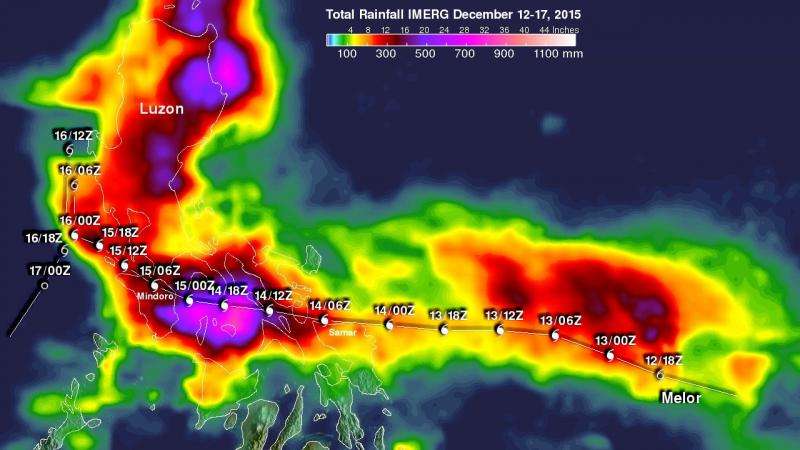NASA finds huge rainfall totals from Typhoon Melor over Philippines

NASA'S Multi-satellitE Retrievals for GPM (IMERG) data collected from December 12 to 17, 2015 were used to update Typhoon Melor's rainfall totals. The central Philippines received the largest amount of rainfall that measured almost three feet.
Northern Luzon escaped the damaging winds of Typhoon Melor but moisture transported by the tropical cyclone caused flooding rainfall in that area. IMERG data showed that much of Luzon was found to have rainfall totals of over 200 mm (7.9 inches) during this period. Unexpectedly heavy rain totaling over 771 mm (30.4 inches) fell over northeastern Luzon. The highest rainfall totals during this five day period were still found along the typhoon's path in the central Philippines where rainfall totals were now measured by IMERG at over 899 mm (35.4 inches).
The Integrated Multi-satellitE Retrievals for GPM (IMERG) creates a merged precipitation product from the GPM constellation of satellites. These satellites include DMSPs from the U.S. Department of Defense, GCOM-W from the Japan Aerospace Exploration Agency (JAXA), Megha-Tropiques from the Centre National D'etudies Spatiales (CNES) and Indian Space Research Organization (ISRO), NOAA series from the National Oceanic and Atmospheric Administration (NOAA), Suomi-NPP from NOAA-NASA, and MetOps from the European Organisation for the Exploitation of Meteorological Satellites (EUMETSAT). All of the instruments (radiometers) onboard the constellation partners are intercalibrated with information from the GPM Core Observatory's GPM Microwave Imager (GMI) and Dual-frequency Precipitation Radar (DPR).
After crossing the northern and central Philippines and emerging in the South China Sea on Thursday, December 17, Melor dissipated over the waters of South China Sea.
Provided by NASA's Goddard Space Flight Center



















